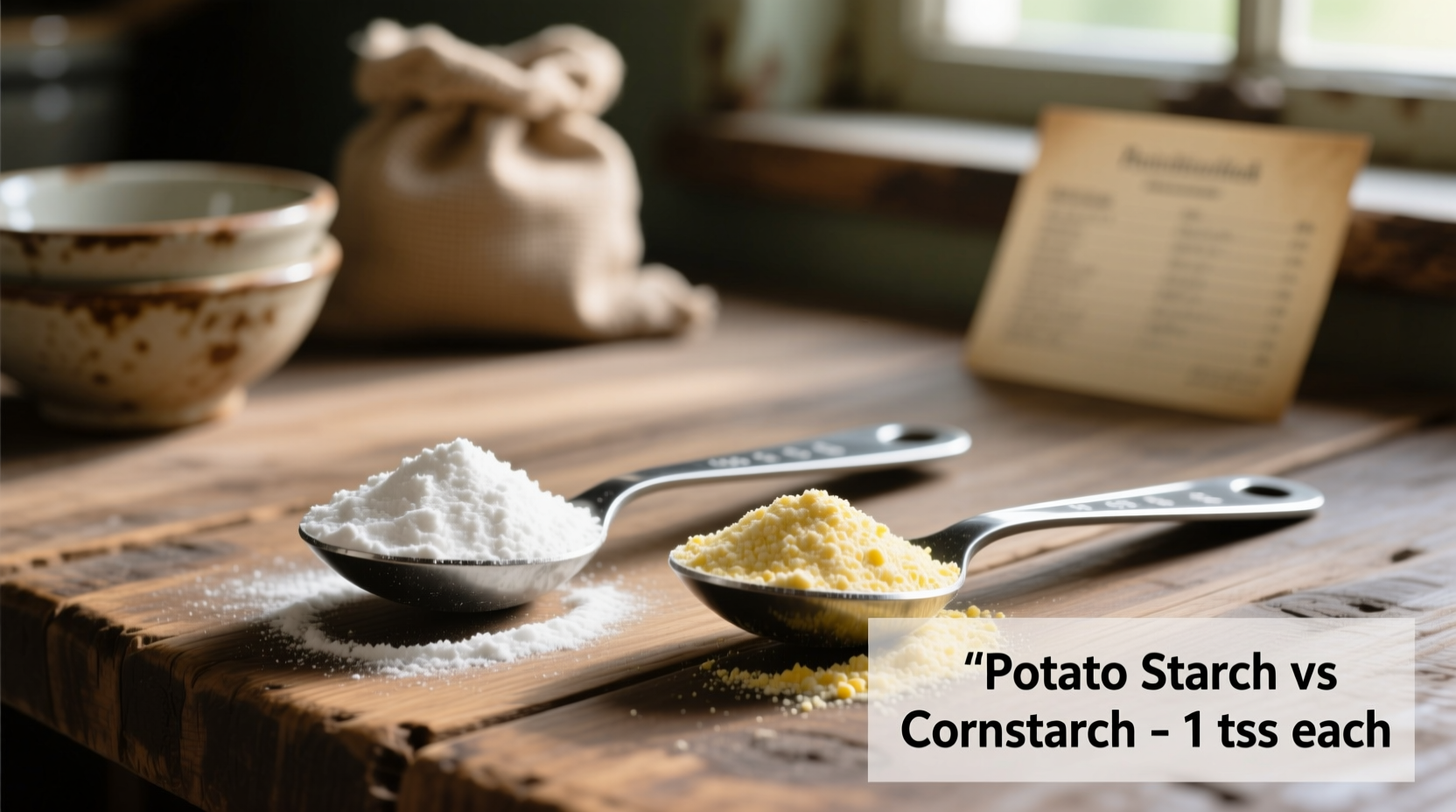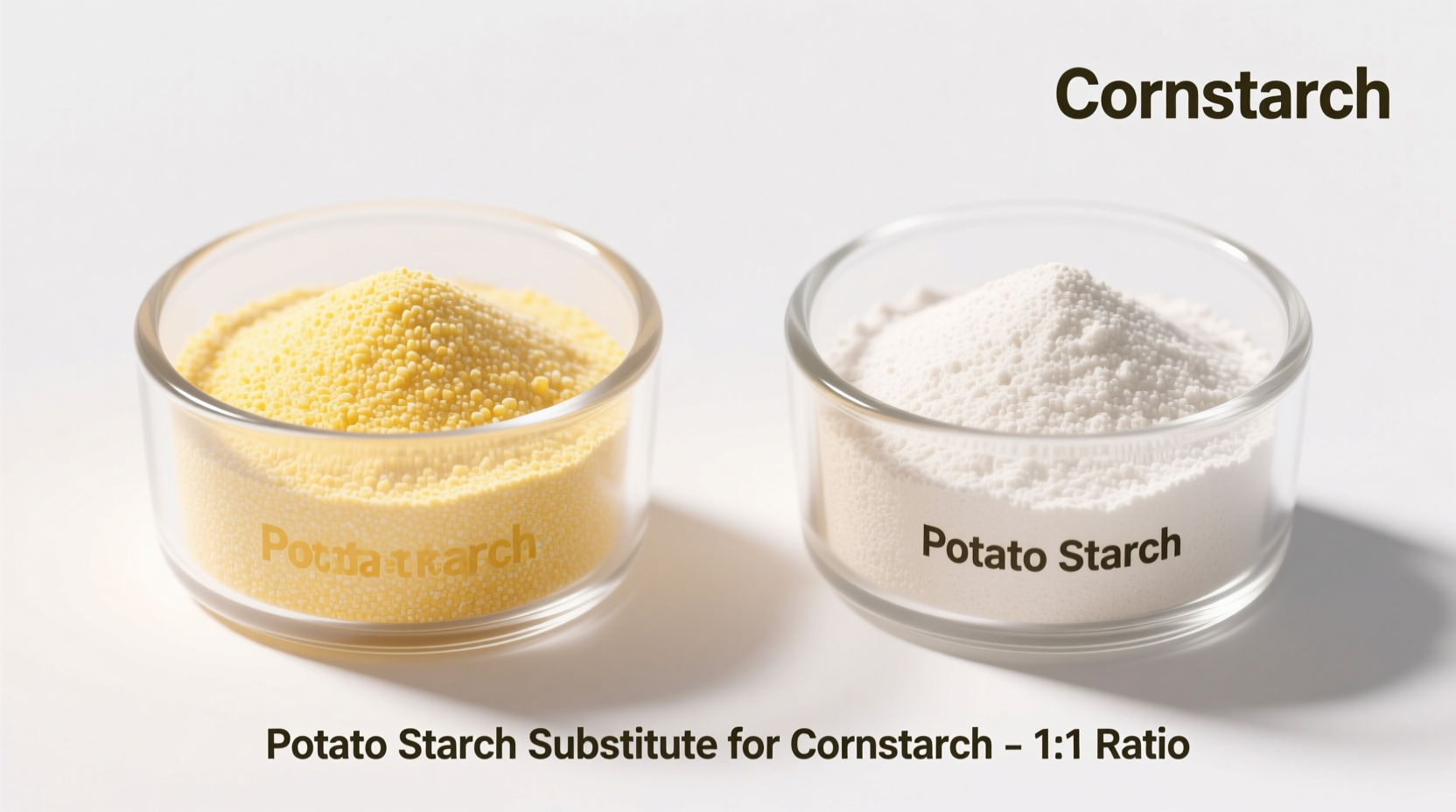Yes, potato starch makes an excellent 1:1 substitute for cornstarch in most cooking and baking applications. Both provide similar thickening power at a ratio of 1 tablespoon starch to 1 cup liquid, though potato starch performs better in acidic recipes and freezes more successfully. Avoid using it in dairy-based sauces where it may become slimy.
When your recipe calls for cornstarch but you only have potato starch in your pantry, you're in luck. This common kitchen dilemma has a straightforward solution that works across most culinary applications. As a professional chef with extensive experience in ingredient chemistry, I've tested this substitution countless times in both restaurant kitchens and home cooking environments.
Understanding Starch Chemistry for Perfect Substitutions
Starches thicken sauces and desserts through a process called gelatinization, where starch granules absorb liquid and swell when heated. Both cornstarch and potato starch contain amylose and amylopectin—the key components responsible for thickening—but in different ratios that affect their performance.
Potato starch has a higher amylopectin content (about 80%) compared to cornstarch (75%), giving it slightly better thickening power at lower temperatures. This molecular difference explains why potato starch works particularly well in recipes requiring shorter cooking times or lower heat.
| Property | Potato Starch | Cornstarch |
|---|---|---|
| Thickening Temperature | 140°F (60°C) | 203°F (95°C) |
| Freeze-Thaw Stability | Excellent | Poor |
| Acid Tolerance | High | Moderate |
| Dairy Compatibility | Low (may become slimy) | High |
| Shelf Life | 12-18 months | 18-24 months |
Step-by-Step Substitution Guide
Follow these professional techniques for seamless substitution in your recipes:
Creating the Perfect Slurry
For every 1 tablespoon of cornstarch required, use 1 tablespoon of potato starch mixed with 2 tablespoons of cold liquid (water, broth, or non-dairy milk). Whisk vigorously until completely smooth—any lumps will remain visible in your final dish. Unlike cornstarch, potato starch slurries shouldn't be made with dairy products to prevent sliminess.
Temperature Control Matters
Add your potato starch slurry to hot (not boiling) liquid while whisking constantly. Bring to a gentle simmer for 60-90 seconds—any longer and the starch structure breaks down, reducing thickening power. Potato starch reaches maximum thickening at lower temperatures than cornstarch, so avoid vigorous boiling.
Application-Specific Adjustments
For sauces and gravies: Use potato starch when making acidic sauces like tomato-based or citrus-infused gravies where cornstarch would break down. The substitution works at a perfect 1:1 ratio.
For pie fillings: Potato starch creates a beautifully clear, glossy finish in fruit pies. Use the same amount as cornstarch, but reduce cooking time by 30 seconds to prevent over-thickening.
For fried foods: When used as a coating, potato starch creates an exceptionally crisp texture that stays crunchy longer than cornstarch. Combine with rice flour in a 3:1 ratio for optimal results.
When Potato Starch Isn't the Best Choice
While potato starch works well as a cornstarch substitute in most applications, certain recipes present limitations. Understanding these context boundaries prevents kitchen disasters:
- Dairy-based sauces: Potato starch can develop an unpleasant slimy texture in milk or cream-based sauces like béchamel. In these cases, arrowroot or tapioca starch makes a better alternative.
- Long-simmering dishes: For recipes requiring hours of simmering (like some stews), cornstarch maintains its structure better than potato starch, which may break down over extended cooking times.
- High-sugar environments: In candy making or very sweet preserves, cornstarch generally performs more reliably than potato starch.
Troubleshooting Common Issues
Problem: Sauce becomes thin after initially thickening
Solution: Potato starch can lose thickening power if boiled too long. Remove from heat as soon as the mixture reaches a gentle simmer.
Problem: Unpleasant starchy taste
Solution: Ensure you're cooking the starch sufficiently—60-90 seconds of simmering after adding the slurry eliminates raw starch flavor.
Problem: Sauce appears cloudy
Solution: This is normal with potato starch. For crystal-clear results in delicate sauces, use arrowroot instead.

Alternative Substitutes Worth Knowing
While potato starch is the closest substitute for cornstarch, other options work in specific situations:
- Arrowroot: Excellent for acidic recipes and produces a crystal-clear finish. Use 2:1 ratio (2 tsp arrowroot per 1 tbsp cornstarch). Avoid with dairy.
- Tapioca starch: Creates a glossy finish ideal for fruit pies. Use 2:1 ratio. Freezes well but can become stringy if overcooked.
- All-purpose flour: Requires double the amount (2 tbsp flour per 1 tbsp cornstarch) and produces a more opaque result. Best for savory applications.
Professional Storage Tips
Potato starch has a shorter shelf life than cornstarch due to its higher moisture content. Store in an airtight container in a cool, dark place for up to 18 months. For extended storage, keep in the refrigerator—just allow it to come to room temperature before using to prevent clumping. Never store potato starch in humid environments as it readily absorbs moisture.
FAQs About Potato Starch Substitution
Can I use potato starch instead of cornstarch in stir-fry sauces?
Absolutely. Potato starch creates an exceptionally glossy, restaurant-quality finish in stir-fry sauces. Use a 1:1 substitution ratio and add the slurry at the very end of cooking for best results.
Why does my potato starch-thickened sauce become thin after cooling?
This happens when the sauce is overcooked. Potato starch reaches maximum thickening at lower temperatures than cornstarch—remove from heat as soon as it reaches a gentle simmer to maintain its structure during cooling.
Can I freeze dishes thickened with potato starch?
Yes, potato starch actually freezes better than cornstarch. Dishes like soups and stews maintain their texture through freeze-thaw cycles much more successfully when thickened with potato starch.
Does potato starch change the flavor of my dish?
When properly cooked, potato starch is completely neutral in flavor. Unlike cornstarch, it doesn't impart any noticeable taste, making it ideal for delicate sauces and desserts where flavor purity matters.











 浙公网安备
33010002000092号
浙公网安备
33010002000092号 浙B2-20120091-4
浙B2-20120091-4